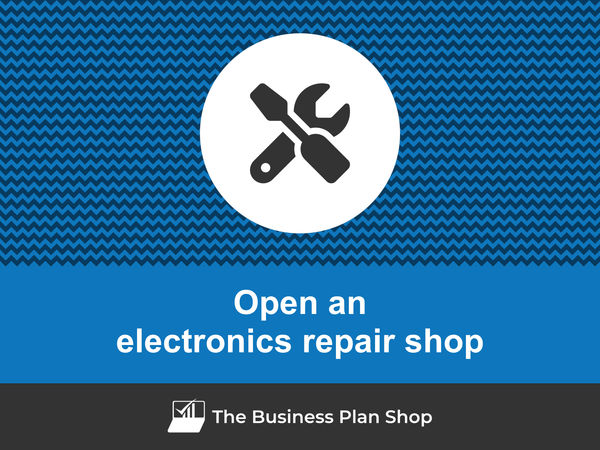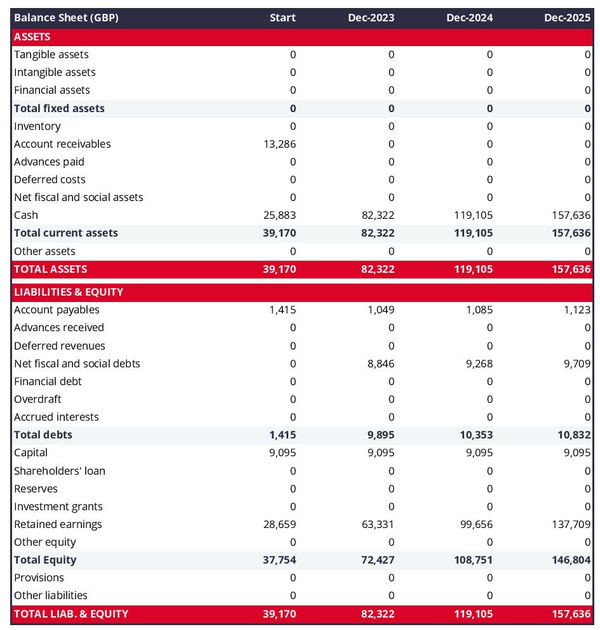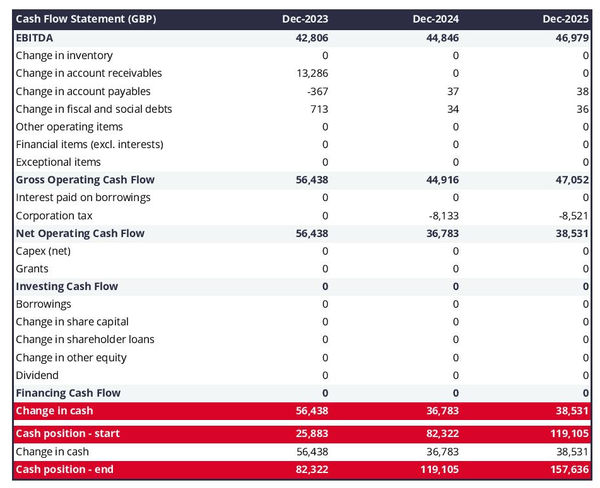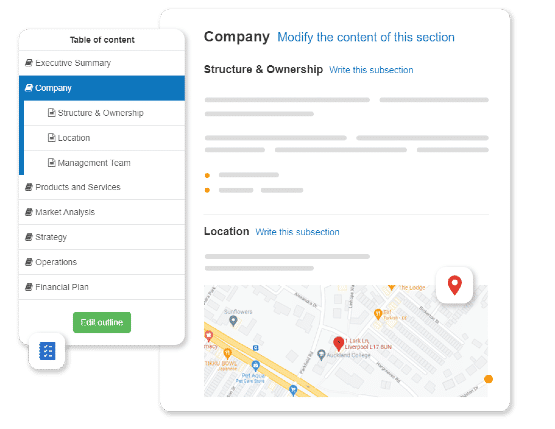How to open an electronics repair shop?

Want to start an electronics repair shop but don't know where to begin? Then you've come to the right place!
Our comprehensive guide covers everything related to opening an electronics repair shop - from choosing the right concept to setting out your marketing plan and financing your business.
You'll also learn how to assess the profitability of your business idea and decide whether or not it can be viable from a financial perspective.
Ready to kickstart your entrepreneurial journey? Let's begin!
Understanding how an electronics repair shop works
The very first step when exploring a business idea such as starting an electronics repair shop is to make sure you understand how the business operates and makes money (which is what we call the business model).
This will not only give you an initial idea of how profitable the business can be, but it will also enable you to make sure that this is the right business idea for you, given your skills, start-up capital and family or personal lifestyle, in particular.
The best ways to get to grips with the electronics repair shop's business model are to:
- Talk to electronics repair shop owners with experience
- Work a few months in an electronics repair shop already in operation
- Take a training course
Talk to electronics repair shop owners with experience
Experienced electronics repair shop owners have valuable insights and can provide practical advice based on their firsthand experiences.
They've likely encountered and overcome challenges that a newcomer might not anticipate. Learning from other’s mistakes can save you both time and money and potentially increase your venture’s chances of succeeding.
Work a few months in an electronics repair shop already in operation
Obtaining work experience in the industry can be a crucial factor in confirming whether you truly want to start an electronics repair shop, as it provides insight into the day-to-day activities.
For instance, if the working hours are longer than expected or if other business requirements don't align with your personal lifestyle or preferences, you might reconsider your entrepreneurial goals.
Even if you've decided that this business idea is a good fit for you, gaining work experience will still be valuable. It helps you better understand your target market and customer needs, which is likely to be beneficial when launching your own electronics repair shop.
Take a training course
Obtaining training within your chosen industry is another way to get a feel for how an electronics repair shop works before deciding to pursue a new venture.
Whatever approach you choose to familiarise yourself with the business, before going any further with your plans to open an electronics repair shop, make sure you understand:
- What skills are required to run the business (compare this with your own skills)
- What a typical week in the business is like (compare this with your personal or family life)
- What is the potential turnover of an electronics repair shop and the long-term growth prospects (compare this with your level of ambition)
- Your options once you decide to sell the business or retire (it's never too early to consider your exit)
Can your business idea be profitable?
Just enter your data and let The Business Plan Shop crunch the numbers. We will tell if your business idea can generate profits and cash flows, and how much you need to get started.

Assembling your electronics repair shop's founding team
The next step to opening your electronics repair shop is to think about the ideal founding team, or to decide to go in alone.
Starting and growing a successful business doesn't have to be a solo journey and setting up an electronics repair shop with several co-founders is generally easier. The business benefits from a management team with a wider skillset, decisions are made together, and the financial risk is shared among the partners, making the journey more collaborative and less daunting.
But, running a business with several partners brings its own challenges. Disagreements between co-founders are quite common, and these can pose risks to the business. That's why it's crucial to consider all aspects before starting your own business.
We won't go into too much detail here, as this is a complex topic that deserves its own guide, but we do recommend that you ask yourself the following questions:
- What is the ideal number of co-founders for this venture?
- Are you on the same wavelength as your potential partners in terms of vision and ambition?
- How will you deal with potential failure?
Let's look at each of these questions in more detail.
What is the ideal number of co-founders for this venture?
To answer this question you will need to consider the following:
- What skills do you need to run the business? Are you lacking any?
- How much startup capital do you need? How much do you have?
- How are key decisions going to be made? - It is usually advisable to have an odd number of partners (or a majority shareholder) to help break the tie.
Put simply, your co-founders contribute skills, capital, or both. Increasing the number of partners becomes advantageous when there is a deficiency in either of these resources.
Are you on the same wavelength as your potential partners in terms of vision and ambition?
Your business partners should share the same short and long-term vision, be it business expansion or social responsibility, to avoid future frustrations and simplify decision-making. Different views are natural, but alignment is ideal.
In any case, you should think of having an exit mechanism in place in case one of the partners wants to move on.
How will you deal with potential failure?
We wish you nothing but success when starting up and growing your electronics repair shop, but it's always wise to have a backup in case things don't go as planned.
How you deal with a potential failure can vary significantly based on the relationship you have with your business partner (close friend, spouse, ex-colleague, etc.) and the personal circumstances of each of you.
For instance, starting a business with your spouse might seem appealing, but if it doesn't succeed, you risk losing 100% of the household income at once, which could be stressful.
Similarly, going into a partnership with a friend can put pressure on the friendship in the event of failure or when you need to make difficult decisions.
There is no wrong answer, but it is essential to carefully evaluate your options before starting up to ensure you're well-prepared for any potential outcomes.
Conducting market research for an electronics repair shop
The next step in launching an electronics repair shop is to carry out market research. Let's take a look at what this involves.
The objectives of market research
The objective here is very simple: to assess the level of demand for your business and whether there is an opportunity for it to thrive in your chosen location.
The first step will be to check that the market is not saturated with competing offers and that there is room for a new player: your electronics repair shop.
Your market analysis will also help you identify a concept and market positioning that has every chance of being successful in your target market, thereby helping increase your business's chances of success.
Carrying out market research for your electronics repair shop will also enable you to better understand the expectations of your future customers and the most effective ways to communicate with them in your marketing plan.
Analyse key trends in the industry
Your market research should start with an industry analysis in order to gain a good understanding of the main players and current trends in your sector.
Once you've delved into the current state of the market, it will be time to assess what proportion of your target market can be seized by your electronics repair shop. To do this, you will need to consider both the demand and supply side of the market.
Assess the demand
After checking out the industry, let's shift our focus to figuring out what your potential customers want and how they like to buy.
A classic mistake made by first-time entrepreneurs is to assess demand on the global or national market instead of concentrating on their target market. Only the market share that can be captured by your company in the short term matters.
Your demand analysis should seek to find answers to the following questions:
- Who are your target customers?
- How many are there?
- What are their expectations?
- What are their buying habits?
- How much budget do they have?
- What are the different customer segments and their characteristics?
- What are the main distribution channels and means of communication for reaching each segment?
The aim of the demand analysis is to identify the customer segments that could be targeted by your electronics repair shop and what products and services you need to offer to meet their expectations.
Analyse the supply side
You will also have to familiarize yourself with the competing electronics repair shops on the market targeted by your future business.
Amongst other things, you’ll need to ask yourself:
- Who are the main competitors?
- How many competitors are already present?
- Where are they located?
- How many people do they employ?
- What is their turnover?
- How do they set their prices?
- Are they small independent businesses or national players?
- Do they seem to be in difficulty or are they flourishing?
- What is their market positioning?
- What types of products and services do they offer?
- What do customers seem to like about them?
The aim of the competitive analysis is to identify who your competitors will be and to gather information that will help you find a differentiating commercial positioning (more on that later in this guide).
Regulations
Conducting market research is also an opportunity to look at the regulations and conditions required to do business.
You should ask yourself the following questions:
- Do you need to have a specific degree to open an electronics repair shop?
- Do you need specific licences or permits?
- What are the main regulations applicable to your future business?
Given that your project is at an early stage, your focus should be to ensure that there are no roadblocks from a regulatory standpoint before you deep dive into the planning process.
Once your project is more advanced, you will have the opportunity to talk about regulation more in-depth with your lawyer.
Concluding your market research
By the time your market research is completed, you should have either:
- Pinpointed an untapped business opportunity,
- Or arrived at the realisation that the market is saturated, prompting the search for alternative business ideas or models.
If the conclusion is that there is an opportunity in the market to cater to one or more customer segments currently underserved by competitors, that's great!
Conversely, if you come to the conclusion that the market is already saturated, don’t panic! The good news is that you won’t spend several years working hard on a project that has little chance of success. There is no shortage of business ideas either - at The Business Plan Shop, we have identified more than 1,300 potential business ideas!
Need a convincing business plan?
The Business Plan Shop makes it easy to create a financial forecast and write a business plan to help convince investors that your business idea can be profitable.

How should I position my electronics repair shop on the market?
The next step to start your electronics repair shop is to define precisely the market positioning your company will adopt in order to capitalise on the opportunity identified during your market research.
Market positioning refers to the place your product and service offering occupies in customers' minds and how they differ from the competition. Being perceived as a low-cost solution, for example.
To find a concept and a market positioning that will resonate with your customers, you need to address the following issues:
- How can you differentiate yourself from your competitors?
- Is it better to start or buy an electronics repair shop already in operation?
- How will you validate your concept and market positioning before investing in the business?
Let's look at these aspects in more detail.
How can you differentiate yourself from your competitors?
Opening an electronics repair shop means starting with a major disadvantage compared with competitors already active on the market.
While you will have to create everything from scratch, your competitors already have everything in place.
Your competitors' teams know the business well, whereas yours has only just been recruited, their customers are loyal and they benefit from word of mouth that you don't yet have.
So you're going to need a solid plan to succeed in taking market share from your competitors and making your mark.
There are a number of aspects to consider in order to try to avoid direct confrontation if possible:
- Can you target a different customer base than your competitors?
- Can you offer products or services that are different from or complementary to what your competitors already sell?
- How will your competitors react to your electronics repair shop entering their market?
- Can you build a sustainable competitive advantage that will enable you to compete with your current and future competitors?
Is it better to start or buy an electronics repair shop already in operation?
The alternative to setting up a new independent business is to buy out and take over an electronics repair shop already in operation.
A takeover is a good way of reducing the risk of your project compared with a pure start-up.
Taking over a business has two enormous advantages over setting up a new one: you start out on an equal footing with your competitors since you take over the team and the customer base, and you don't increase the supply on the market enabling you to maintain the existing balance on the market where the business operates.
However, the capital requirements for a takeover are higher because the business will have to be bought from its previous owners.
How will you validate your concept and market positioning before investing in the business?
However you decide to set up your business, you will need to ensure that there is a good fit between what you sell and what customers are looking to buy.
To do this, you'll need to meet your target customers to present your products or services and check that they meet their expectations.
Explore the ideal location to start your electronics repair shop
The next stage in our guide on how to start an electronics repair shop: choosing where to set up shop.
Setting up your business in the right location will have a direct impact on your chances of success, so it's a good idea to think things through before you launch.
To help you decide where to set up your business, we recommend considering the following factors:
- Visibility and foot traffic - An electronics repair shop would benefit from high visibility and foot traffic to attract potential customers and increase brand awareness. A location near a busy street or in a shopping center would be ideal.
- Parking space, road and public transport accessibility - This is important for customers who may need to drop off or pick up their electronics for repair. Easy access to parking and public transportation would make it more convenient for them to visit the shop.
- Availability of skilled labor - An electronics repair shop would require skilled technicians to handle repairs, so a location with access to a pool of qualified workers would be beneficial.
- Competitor presence - While having competitors nearby may seem like a disadvantage, it can also indicate a high demand for electronics repair services in the area. This can be a potential customer base for the shop.
These criteria will need to be refined according to the specific features of your project.
After weighing the factors mentioned earlier, it's crucial to focus on your startup's budget. Look for a location that suits your business needs while being affordable, especially in the short term.
One of the issues that will also come up is the long-term future of your location, particularly if you opt to rent your premises rather than buy. In this case, you will need to consider the conditions for renewing the lease (duration, rent increases, etc.).
Lease agreements vary widely from country to country, so make sure you check the terms applicable to your situation and have your lawyer review your lease before you sign.
Need inspiration for your business plan?
Avoid writer's block and draft your own business plan in no time by drawing inspiration from dozens of business plan templates.

Decide on a legal form for your electronics repair shop
It's now time to think about the legal structure for your electronics repair shop.
The legal form of a business simply means the legal structure it operates under. This structure outlines how the business is set up and defines its legal obligations and responsibilities.
What are the most common legal structures?
Naturally, the names and intricacies of business structures differ by country. However, they typically fit into two main categories:
- Individual businesses
- Companies
Individual businesses
Individual businesses are usually a good fit for self-employed individuals and freelancers who want limited administrative work. These types of entrepreneurs are commonly referred to as sole traders or sole proprietorships.
As mentioned above, the main benefit of being a sole trader is that minimal paperwork is required to launch and operate the business. Tax calculations are also relatively simple and annual accounts are not always required (and when they are, usually don't need to be audited) which saves a bit of time and money on bookkeeping and accounting fees.
Decision-making is also easy as the final decision is fully dependent on the sole trader (even if employees are hired).
However, being a sole trader also has drawbacks. The main disadvantage is that there is no separation between the individual running day-to-day operations and the business.
This means that if the business were to file for bankruptcy or legal disputes were to arise, the individual would be liable for any debts and their personal assets subsequently at risk. In essence, sole traders have unlimited liability.
This also means that profits earned by the business are usually taxed under the personal income tax category of the sole trader.
Another drawback is that sole traders might find it harder to finance their business. Debt (bank loan for example) is likely to be the only source of external financing given that the business doesn't have a share capital (effectively preventing equity investors from investing in their business).
Companies
Companies are more flexible and more robust than individual businesses. They are suitable for projects of all sizes and can be formed by one or more individuals, working on their own or with employees.
Unlike individual businesses, companies are recognised as distinct entities that have their own legal personality. Usually, there is also a limited liability which means that founders and investors cannot lose more than the capital they have invested into the business.
This means that there is a clear legal separation between the company and its owners (co-founders and investors), which protects the latter's personal assets in the event of legal disputes or bankruptcy.
Entrepreneurs using companies also gain the advantage of being able to attract equity investment by selling shares in the business.
As you can see companies offer better protection and more financing options, but this comes at a trade-off in terms of red-tape and complexity.
From a taxation perspective, companies are usually liable for corporation tax on their profits, and the income received by the owners running the business is taxed separately (like normal employees).
Normally, companies also have to produce annual accounts, which might have to be audited, and hold general assemblies, among other formalities.
How should I choose my electronics repair shop's legal setup?
Choosing the right legal setup is often simple once you figure out things like how many partners you'll have, if you hire employees, and how much money you expect to make.
Remember, a great business idea can work well no matter which legal structure you pick. Tax laws change often, so you shouldn't rely too much on getting specific tax benefits from a certain structure when getting started.
You could start by looking at the legal structures most commonly utilised by your competitors. As your idea evolves and you're ready to officially register your business, it's a good idea to confirm your choice using inputs from a lawyer and an accountant.
Can I switch my electronics repair shop's legal structure if I get it wrong?
Yes, you have the flexibility to change your legal setup later, which might include selling the existing one and adopting a new structure in certain situations. Keep in mind, though, that this restructuring comes with additional expenses, so making the right choice from the start is usually more cost-effective.
Can your business idea be profitable?
Just enter your data and let The Business Plan Shop crunch the numbers. We will tell if your business idea can generate profits and cash flows, and how much you need to get started.

Assess the startup costs for an electronics repair shop
The next step in creating an electronics repair shop involves thinking about the equipment and staff needed for the business to operate.
After figuring out what you need for your business, your financial plan will reveal how much money you'll need to start and how much you might make (check below for more details).
Because every venture is distinctive, providing a reliable one-size-fits-all budget for launching an electronics repair shop without knowing the specifics of your project is not feasible.
Each project has its own particularities (size, concept, location), and only a forecast can show the exact amount required for the initial investment.
The first thing you'll need to consider is the equipment and investments you'll need to get your business up and running.
Startup costs and investments to launch your electronics repair shop
For an electronics repair shop, the initial working capital requirements (WCR) and investments could include the following elements:
- Equipment: This includes all the tools and machinery needed for repairing electronics, such as soldering irons, multimeters, oscilloscopes, and other specialized equipment. These are essential for providing quality repairs and maintaining the efficiency of your shop.
- Furniture and Fixtures: This category includes items like workbenches, chairs, and shelves, as well as any fixtures needed for proper lighting and organization of your workspace. These items are necessary for creating a comfortable and functional environment for your technicians to work in.
- Inventory: As an electronics repair shop, you will need to maintain a stock of various electronic components, such as resistors, capacitors, and IC chips. These items can be expensive and need to be regularly replenished to ensure you can quickly and efficiently complete repairs for your customers.
- Software and Technology: In today's digital age, having the right software and technology is crucial for running a successful electronics repair shop. This includes things like diagnostic software, inventory management systems, and customer relationship management tools. These investments can help streamline your business operations and improve customer satisfaction.
- Vehicles: If you offer on-site repairs or have a pick-up and delivery service, you may need to invest in a vehicle for your business. This could include a van, truck, or even a small car for transporting equipment and technicians to different locations.
Of course, you will need to adapt this list to your business specificities.
Staffing plan of an electronics repair shop
In addition to equipment, you'll also need to consider the human resources required to run the electronics repair shop on a day-to-day basis.
The number of recruitments you need to plan will depend mainly on the size of your company.
Once again, this list is only indicative and will need to be adjusted according to the specifics of your electronics repair shop.
Other operating expenses for an electronics repair shop
While you're thinking about the resources you'll need, it's also a good time to start listing the operating costs you'll need to anticipate for your business.
The main operating costs for an electronics repair shop may include:
- Staff costs: Includes wages, salaries, benefits, and training for employees such as technicians and customer service representatives.
- Accountancy fees: Expenses for hiring an accountant to manage your financial records and taxes.
- Insurance costs: Includes liability insurance, workers' compensation, and property insurance to protect your business from potential risks and losses.
- Software licenses: Fees for purchasing and renewing licenses for software programs used in the repair shop, such as diagnostic tools and accounting software.
- Banking fees: Charges for services such as checking accounts, credit card processing, and wire transfers.
- Rent: Monthly expenses for leasing a space to operate the repair shop.
- Utilities: Costs for electricity, water, and gas used in the repair shop.
- Inventory: Expenses for purchasing parts and supplies needed for repairs.
- Marketing and advertising: Includes costs for promoting your repair shop through methods such as online ads, flyers, and promotions.
- Equipment maintenance: Expenses for regular maintenance and repairs for equipment used in the repair shop, such as soldering irons and diagnostic tools.
- Vehicle expenses: If you offer mobile repair services, this includes costs for gas, maintenance, and insurance for your repair vehicle.
- Phone and internet: Monthly expenses for phone and internet services used for communication and online operations.
- Training and certifications: Costs for employees to attend training programs and obtain certifications in order to stay updated on the latest repair techniques and technologies.
- Office supplies: Expenses for purchasing office supplies such as paper, ink, and pens.
- Legal fees: Costs for hiring a lawyer for legal advice and services related to your repair shop.
Like for the other examples included in this guide, this list will need to be tailored to your business but should be a good starting point for your budget.
Create a sales & marketing plan for your electronics repair shop
The next step to launching your electronics repair shop is to think about the actions you need to take to promote your products and services and build customer loyalty.
Here, you'll be looking at the following issues:
- What is the best method to attract as many new customers as possible?
- How to build customer loyalty and spread word of mouth?
- What human and financial resources will be required to implement the planned actions?
- What level of sales can I expect to generate in return?
The precise sales and marketing levers to activate will depend on the size of your electronics repair shop. But you could potentially leverage some of the initiatives below.
Besides your sales and marketing plan, your sales forecast will be affected by seasonal patterns related to the nature of your business, such as fluctuations during the holiday season, and your competitive landscape.
Can your business idea be profitable?
Just enter your data and let The Business Plan Shop crunch the numbers. We will tell if your business idea can generate profits and cash flows, and how much you need to get started.

Build your electronics repair shop's financial forecast
The next step to start your electronics repair shop: putting your financial projections together.
What is the financial forecast for an electronics repair shop?
A forecast is a quantified decision-making document that shows the initial investment required to open an electronics repair shop and the company's potential profitability and cash flow generation over the next 3 to 5 years.
As you think about your electronics repair shop idea, the main role of financial projections will be to help you decide whether it makes sense to create the company.
Building a financial forecast helps determine the amount of initial financing required to start your electronics repair shop.
In fact, creating financial projections is the only way to assess the amount of initial financing you'll need to open your electronics repair shop, and to make sure your project makes economic and financial sense.
Keep in mind that very few business ideas are financially viable. At The Business Plan Shop, we've seen nearly a million business start-up ideas, and we estimate that less than one in four is economically viable.
Your forecast will therefore require your full attention and constant revision, as your project matures. It's also a good idea to simulate different scenarios to anticipate several possibilities (what happens if your sales take longer than expected to ramp up, for example), so you're ready for all eventualities.

When seeking financing, your forecast will be incorporated into your business plan, which is the document you will use to present your business idea to financial partners. We'll come back to the business plan in more detail later in this guide.
Creating and updating your electronics repair shop's forecast is an ongoing process. Indeed, having up-to-date financial projections is the only way to maintain visibility over your company's future cash flow and cash position.
Forecasting is, therefore, the financial management tool that will be with you throughout the life of your company. Once you've started trading, you'll need to regularly compare the difference between your actual accounts and your forecasts, and then adjust them to maintain visibility over your future cash flows.
What does a financial projection look like?
The following financial tables will be used to present your electronics repair shop's financial forecast.
The projected P&L statement
Your electronics repair shop's forecasted P&L statement will enable you to visualise your electronics repair shop's expected growth and profitability over the next three to five years.

The projected balance sheet of your electronics repair shop
The projected balance sheet gives an overview of your electronics repair shop's financial structure at the end of the financial year.

The cash flow projection
A cash flow forecast for an electronics repair shop shows the projected inflows and outflows of cash over a specific period, providing insights into liquidity and financial health.

Which solution should you use to make a financial projection for your electronics repair shop?
Using an online financial forecasting tool, such as the one we offer at The Business Plan Shop, is the simplest and safest solution for forecasting your electronics repair shop.
There are several advantages to using specialised software:
- You can easily create your financial forecast by letting the software take care of the financial calculations for you without errors
- You have access to complete financial forecast templates
- You get a complete financial forecast ready to be sent to your bank or investors
- The software helps you identify and correct any inconsistencies in your figures
- You can create scenarios to stress-test your forecast's main assumptions to stress-test the robustness of your business model
- After you start trading, you can easily track your actual financial performance against your financial forecast, and recalibrate your forecast to maintain visibility on your future cash flows
- You have a friendly support team on standby to assist you when you are stuck
If you are interested in this type of solution, you can try our forecasting software for free by signing up here.
How do I choose a name and register my electronics repair shop?
Now that your project of launching an electronics repair shop is starting to take shape, it's time to look at the name of your business.
Finding the name itself is generally fairly easy. The difficulty lies in registering it.
To prevent this guide from being too long, we won't go into all the criteria you need to take into account when choosing a striking name for your electronics repair shop. However, try to choose a name that is short and distinctive.
Once you have a name that you like, you need to check that it is available, because you cannot use a name that is identical or similar to that of a competitor: this type of parasitic behaviour is an act of unfair competition for which you risk being taken to court by your competitors.
To avoid any problems, you will need to check the availability of the name:
- Your country's company register
- With the trademark register
- With a domain name reservation company such as GoDaddy
- On an Internet search engine
If the desired name is available, you can start the registration process.
It is common to want to use the trading name as the name of the company, and to have a domain name and a registered trademark that also correspond to this name: Example ® (trading name protected by a registered trademark), Example LTD (legal name of the company), example.com (domain name used by the company).
The problem is that each of these names has to be registered with a different entity, and each entity has its own deadlines:
- Registering a domain name is immediate
- Registering a trademark usually takes at least 3 months (if your application is accepted)
- The time taken to register a new business depends on the country, but it's generally quite fast
How do I go about it?
Well, you have two choices:
- Complete all registrations at the same time and cross your fingers for a smooth process.
- Make sure to secure the domain names and trademarks. Once that's done, wait for confirmation of a successful trademark registration before moving on to register the company.
At The Business Plan Shop, we believe it's essential to prioritize securing your domain names and trademarks over the business name. This is because you have the flexibility to use a different trading name than your legal business name if needed.
Regardless, we suggest discussing this matter with your lawyer (see below in this guide) before making any decisions.
Need inspiration for your business plan?
Avoid writer's block and draft your own business plan in no time by drawing inspiration from dozens of business plan templates.

Deciding upon the corporate identity of your electronics repair shop
The next step in opening an electronics repair shop is to look at your company's visual identity.
Your company's “visual identity” plays a crucial role in shaping your brand image. It helps you to be recognizable and to stand out from your competitors.
Although you can define your visual identity yourself, it is generally advisable to call on the services of a designer or marketing agency to achieve a professional result.
At a minimum, you will need to define the following elements:
- Logo
- Brand guidelines
- Business cards
- Website theme
Logo
Your electronics repair shop's logo allows others to quickly identify your company. It will be used on all your communication media (website, social networks, business cards, etc.) and official documents (invoices, contracts, etc.).
In addition to its design, it's important that your logo is available in a variety of colors, so that it can be seen on all media (white, dark background, etc.).
Brand guidelines
Having brand guidelines enables you to maintain consistency in formatting across all your communications media and official documents.
Brand guidelines define the font (family and size), design and colours used by your brand.
In terms of fonts, for example, you may use Roboto in size 20 for your titles and Lato in size 14 for your texts.
The colours used to represent your brand should generally be limited to five:
- The main colour,
- A secondary colour (the accent),
- A dark background colour (blue or black),
- A grey background colour (to vary from white),
- Possibly another secondary colour.
Business cards
Designing business cards for your electronics repair shop is a must, as they will allow you to communicate your contact details to your customers, suppliers, partners, potential recruits, etc.
In principle, they will include your logo and the brand guidelines that we mentioned above.
Website theme
In the same way, the theme of your electronics repair shop website will be based on your logo and the brand guidelines we mentioned above.
This involves defining the look and feel of your site's main graphic elements:
- Buttons,
- Menus,
- Forms,
- Banners,
- Etc.
Navigate the legal and regulatory requirements for launching your electronics repair shop
The next thing to do in getting an electronics repair shop off the ground is to handle all the legal and regulatory requirements. We recommend that you be accompanied by a law firm for all of the steps outlined below.
Intellectual property
One of your priorities will be to ensure that your company's intellectual property is adequately protected.
As explained before, you can choose to register a trademark. Your lawyer can help you with a detailed search to make sure your chosen trademark is unique and doesn't clash with existing ones.
They'll assist in preparing the required documents and steer you in picking the right categories and locations for trademark registration.
Moreover, your lawyer can offer guidance on additional measures to protect other intellectual property assets your company may have.
Getting your electronics repair shop paperwork in order
For day-to-day operations, your electronics repair shop will need to rely on a set of contractual documents.
Your exact needs in this respect will depend on the country in which you are launching your electronics repair shop, the number of partners and the envisaged size of the company.
However, you will probably need at least the following documents:
- Employment contracts
- General terms and conditions of sale
- General terms and conditions of use for your website
- Privacy Policy for your website
- Cookie Policy for your website
- Invoices
- Etc.
Applying for licences and permits and registering for various taxes
Operating your business legally may require licences and business permits. The exact requirements applicable to your situation will depend on the country in which you set up your electronics repair shop.
The lawyers who advise you will also be able to guide you with regard to all the rules applicable to your business.
Similarly, your accountant will be able to help you take the necessary steps to comply with the tax authorities.
Need a convincing business plan?
The Business Plan Shop makes it easy to create a financial forecast and write a business plan to help convince investors that your business idea can be profitable.

Writing a business plan for your electronics repair shop
The next step in opening an electronics repair shop is to draw up your business plan.
What is a electronics repair shop's business plan?
A business plan serves as a comprehensive roadmap outlining the objectives, strategies, and key components of your venture.
There are two essential parts to a business plan:
- A numerical part, the financial forecast we mentioned earlier in this guide, which highlights the amount of initial financing needed to launch the business and its potential profitability over the next 3 to 5 years,
- A written part, which presents in detail the project of creating an electronics repair shop and provides the necessary context to enable the reader of the business plan to judge the relevance and coherence of the figures included in the forecast.
Your business plan helps guide decision-making by showcasing your vision and financial potential in a coherent manner.
Your business plan will also be essential when you're looking for financing, as your financial partners will ask you for it when deciding whether or not to finance your project to open an electronics repair shop. So it's best to produce a professional, reliable, and error-free business plan.
In essence, your business plan is the blueprint to turn your idea into a successful reality.
What tool should you use to create your electronics repair shop business plan?
If you want to write a convincing business plan quickly and efficiently, a good solution is to use an online business plan software for business start-ups like the one we offer at The Business Plan Shop.

Using The Business Plan Shop to create a business plan for an electronics repair shop has several advantages :
- You can easily create your financial forecast by letting the software take care of the financial calculations for you without errors
- You are guided through the writing process by detailed instructions and examples for each part of the plan
- You can access a library of dozens of complete startup business plan samples and templates for inspiration
- You get a professional business plan, formatted and ready to be sent to your bank or investors
- You can create scenarios to stress test your forecast's main assumptions
- You can easily track your actual financial performance against your financial forecast by importing accounting data
- You can easily update your forecast as time goes by to maintain visibility on future cash flows
- You have a friendly support team on standby to assist you when you are stuck
If you're interested in using our solution, you can try The Business Plan Shop for free by signing up here.
Need a convincing business plan?
The Business Plan Shop makes it easy to create a financial forecast and write a business plan to help convince investors that your business idea can be profitable.

Raise the financing needed to launch your electronics repair shop
With your business plan in hand, you can tackle one of the final steps to open an electronics repair shop business: the search for financing.
Raising the capital needed to launch your business will probably require a combination of equity and debt, which are the two types of financing available to companies.
Equity funding
Equity is the sum of money invested in an electronics repair shop by both founders and investors.
Equity is a key factor in business start-ups. Should the project fail, the sums invested in equity are likely to be lost; these sums therefore enable the founders to send a strong signal to their commercial and financial partners as to their conviction in the project's chances of success.
In terms of return on investment, equity investors can either receive dividends from the company (provided it is profitable) or realize capital gains by selling their shares (provided a buyer is interested in the company).
Equity providers are therefore in a very risky position. They can lose everything in the event of bankruptcy, and will only see a return on their investment if the company is profitable or resold. On the other hand, they can generate a very high return if the project is a success.
Given their position, equity investors look for start-up projects with sufficient growth and profitability potential to offset their risk.
From a technical standpoint, equity includes:
- Share capital and premiums: which represent the amount invested by the shareholders. This capital is considered permanent as it is non-refundable. In return for their investment, shareholders receive shares that entitle them to information, decision-making power (voting in general assembly), and the potential to receive a portion of any dividends distributed by the company.
- Director loans: these are examples of non-permanent capital advanced to the company by the shareholders. This is a more flexible way of injecting some liquidity into your company as you can repay director loans at any time.
- Reserves: these represent the share of profits set aside to strengthen the company's equity. Allocating a percentage of your profits to the reserves can be mandatory in certain cases (legal or statutory requirement depending on the legal form of your company). Once allocated in reserves, these profits can no longer be distributed as dividends.
- Investment grants: which represent any non-refundable amounts received by the company to help it invest in long-term assets.
- Other equity: which includes the equity items which don't fit in the other categories. Mostly convertible or derivative instruments. For a small business, it is likely that you won't have any other equity items.
The main sources of equity are as follows:
- Contributions made by the owners.
- Private investors: business angels, friends and family.
- Crowdfunding: raising funds by involving a group of people through campaigns where they contribute money or make donations, often getting something in return for their support.
- Start-up aid, e.g. government loans to help founders build up their start-up capital.
Debt financing
Debt is the other way of financing companies. Unlike equity, debt offers lenders a limited, contractually guaranteed return on their investment.
Your electronics repair shop undertakes to pay lenders' interest and repay the capital borrowed according to a pre-agreed schedule. Lenders are therefore making money whether or not your company makes a profit.
As a result, the only risk lenders take is that of your electronics repair shop going bankrupt, so they're extremely conservative and will want to see prudent, hands-on management of the company's finances.
From the point of view of the company and all its stakeholders (workforce, customers, suppliers, etc.), the company's contractual obligation to repay lenders increases the risk for all. As a result, there is a certain caution towards companies which are too heavily indebted.
Businesses can borrow debt in two main ways:
- Against assets: this is the most common way of borrowing. The bank funds a percentage of the price of an asset (a vehicle or a building, for example) and takes the asset as collateral. If the business cannot repay the loan, the bank takes the asset and sells it to reduce losses.
- Against cash flows: the bank looks at how much profit and cash flow the business expects to make in the future. Based on these projections, it assigns a credit risk to the business and decides how much the business can borrow and under what terms (amount, interest rate, and duration of the loan).
It's difficult to borrow against future cash flows when you're starting an electronics repair shop, because the business doesn't yet have historical data to reassure about the credibility of cash flow forecast.
Borrowing to finance a portion of equipment purchases is therefore often the only option available to founders. The assets that can be financed with this option must also be easy to resell, in the unfortunate event that the bank is forced to seize them, which could limit your options even further.
As far as possible sources of borrowing are concerned, the main ones here are banks and credit institutions. Bear in mind, however, that each institution is different, in terms of the risk it is prepared to accept, what it is willing to finance, and how the risk of your project will be perceived.
In some countries, it is also possible to borrow from private investors (directly or via crowdfunding platforms) or other companies, but not everywhere.
Key points about financing your electronics repair shop
Multiple solutions are available to help you raise the initial financing you need to open your electronics repair shop. A minimum amount of equity will be needed to give the project credibility, and bank financing can be sought to complete the financing.
Launching your electronics repair shop and monitoring progress against your forecast
Once you’ve secured financing, you will finally be ready to launch your electronics repair shop. Congratulations!
Celebrate the launch of your business and acknowledge the hard work that brought you here, but remember, this is where the real work begins.
As you know, 50% of business start-ups do not pass the five-year mark. Your priority will be to do everything to secure your business's future.
To do this, it is key to keep an eye on your business plan to ensure that you are on track to achieve your goals.
No one can predict the future with certainty, so it’s likely that your electronics repair shop's financial performance will differ from what you predicted in your forecast.
This is why it is recommended to make several forecasts:
- A base case (most likely)
- An optimistic scenario
- And a pessimistic scenario to test the robustness of your financial model
If you follow this approach, your numbers will hopefully be better than your optimistic case and you can consider accelerating your expansion plans. That’s what we wish you anyway!
If, unfortunately, your figures are below your base case (or worse than your pessimistic case), you will need to quickly put in place corrective actions, or consider stopping the activity.
The key, in terms of decision-making, is to regularly compare your real accounting data to your electronics repair shop's forecast to:
- Measure the discrepancies and promptly identify where the variances with your base case come from
- Adjust your financial forecast as the year progresses to maintain visibility on future cash flow and cash position
There is nothing worse than waiting for your accountant to prepare your year-end accounts, which can take several months after the end of your financial year (up to nine months in the UK for example), to realise that the performance over the past year was well below the your base case and that your electronics repair shop will not have enough cash to keep running over the next twelve months.
This is why using a financial forecasting solution that integrates with accounting software and offers actuals vs. forecast tracking out of the box, like the financial dashboards we offer at The Business Plan Shop, greatly facilitates the task and significantly reduces the risk associated with starting a business.
Need inspiration for your business plan?
Avoid writer's block and draft your own business plan in no time by drawing inspiration from dozens of business plan templates.

Key takeaways
- There are 15 key steps to opening an electronics repair shop.
- Your financial forecast will enable you to accurately assess your initial financing requirements and the potential profitability of your project.
- Your business plan will give your financial partners the context they need to be able to judge the consistency and relevance of your forecast before deciding whether or not to finance the creation of your electronics repair shop.
- Post-launch, it's essential to have an up-to-date forecast to maintain visibility of your business's future cash flows.
- Using a financial planning and analysis platform that integrates forecasts, business plans and actual performance monitoring, such as The Business Plan Shop, makes the process easier and reduces the risks involved in starting a business.
We hope this guide has helped you understand how to open an electronics repair shop. Please don't hesitate to contact us if you have any questions or want to share your experience as an entrepreneur.
Also on The Business Plan Shop
Know someone who wants to start an electronics repair shop? Share this guide with them!




